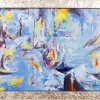Naša talentovana slikarka savremene umetnosti, Gordana Tomić, održala je samostalnu izložbu pod nazivom “Za Beograd pre Njujorka”, u galeriji Singidunum od 6. do 14. marta 2014. godine. Svoja dela ova umetnica predstavila je prvo beogradskoj publici nakon čega sledi izložba u Njujorku, od 5 – 25. jula ove godine. Samostalna izložba u galeriji Singidunum je i svojevrsna najava izložbe u Njujorku, a upravo je ova činjenica postala lajtmotiv izložbe „Za Beograd pre Njujorka“. Radovi slikarke Gordane Tomić, koju na svetskoj sceni savremene umetnosti zastupa njujorška galerija “Agora”, obuhvataju tri ciklusa: ciklus apstrakcija „Tragovi složenih iskušenja“, ciklus apstraktnih aktova „Osvajajući potreti u strasti“ i ciklus apstraktnih pejzaža „Chicago“. Domaća javnost imala je priliku da se na izložbi, u galeriji Singidunum, upozna sa delom opusa iz ciklusa apstrakcija pod nazivom “Tragovi složenih iskušenja”. Na svečanosti povodom otvaranja izložbe, o njenom značaju za savremenu srpsku umetnost, govorio je Zdravko Vučinić, naš istaknuti kritičar i istoričar umetnosti – recenzent kataloga izložbe „Tragovi složenih iskušenja“, Maja Škaljac Stanošević, kustos galerije Singidunum i Tijana Trbović, zamenik umetničkog direktora galerije Prima.
.Nakon izložbe u Beogradu, slikarka će svojim radovima na izložbi u galeriji “Agora” na Menhetnu, simbolično preneti duh Beograda u autentičnu globalnu metropolu, Njujork. Galerija “Agora” se nalazi na respektabilnom šestom mestu globalne mape galerija specijalizovanih za savremenu umetnost i biće zvanični zastupnik Gordane Tomić na medjunarodnoj sceni do kraja 2015. godine. Vredi zabeležiti da će Gordana Tomić biti prva slikaraka sa naših prostora koja će održati izložbu u ovoj galeriji. "Za ovog umetnika lepota umetnosti je izražena u fizici, emocijama i u življenju sada-i-ovde. Kroz jarke boje i često elementarne i amorfne konstrukcije, Tomićeva grabi izvanredne, smislene momente koji definišu njen utisak sveta. Njene slike proširuju naš pogled na svet naglašavajući stalno menjanje pejzaža iskustava u nama." - Citat kriticara Joyce Asper, New York.
Izložba u Njujorku pod nazivom "Cadences of Color", biće svečano otvorena 10. jula od 6 - 8 pm, i trajaće do 25. jula 2014.
Više informacija:





